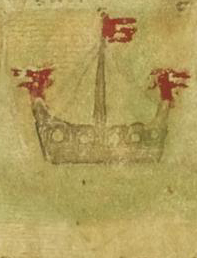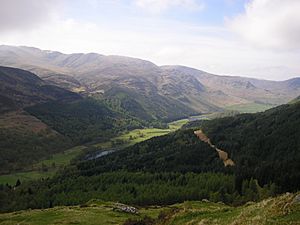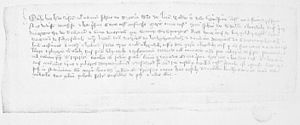John Gallda MacDougall facts for kids
Quick facts for kids
John Gallda MacDougall
|
|
|---|---|
| Lord of Lorne | |

John Gallda's name as recorded by a charter granted in 1339: "Johannes de Ergadia".
|
|
| Died | 1371×1377 |
| Noble family | MacDougall |
| Spouse(s) | Johanna Isaac |
| Father | Allan MacDougall of Argyll |
John Gallda MacDougall (died between 1371 and 1377) was an important Scottish leader in the 1300s. His family, the MacDougalls, had been forced to leave Scotland years before. John Gallda helped them return and become powerful again.
He was the grandson of John MacDougall, Lord of Argyll. This grandfather had been exiled from Scotland. By the mid-1300s, John Gallda married Johanna Isaac, who was the niece of David II, King of Scotland. This marriage helped him get back some of his family's lands in Argyll. The King of Scotland likely supported the MacDougalls to help control other strong leaders nearby. One such leader was John MacDonald, Lord of the Isles, who was a rival of the MacDougalls. John Gallda was close to King David II. However, when Robert II, King of Scotland became king, the MacDougalls lost their special favor. John Gallda was the last MacDougall to be the Lord of Lorne. His daughters inherited the lands, but the leadership of the MacDougall family went to his son born outside of marriage.
Family History

John Gallda was the son of Allan MacDougall of Argyll. Allan was the son of John MacDougall, Lord of Argyll (who died in 1316). The name Gallda means "the foreigner" or "Anglicized." This name was given to people who spoke Scots or English. It also referred to those who had lived in England or non-Gaelic parts of Scotland.
John Gallda's grandfather, John MacDougall, was an enemy of Robert I, King of Scotland. He was an ally of the English kings, Edward I, King of England and Edward II, King of England. After being defeated by Robert I, John MacDougall fled to England. He spent the rest of his life serving the English Crown. His sons, Ewen and Allan (John Gallda's father), both worked in Edward II's royal household.
After Robert I died in 1329, his young son, David II, King of Scotland, became king. Scotland was then attacked by Edward Balliol, who was supported by England. Young David II had to escape to France. Later, David II returned to Scotland in 1341. But five years later, he was captured by the English and held until 1357. John Gallda grew up in England because his father and grandfather were in exile. It's likely that David II's time as a prisoner in England led to their connection.
Returning to Scotland
John Gallda's grandfather died in 1316. What happened to the MacDougalls right after that is not very clear. King Robert I had taken away their family lands. These lands were then given to his supporters, like the MacDonalds, Campbells, and MacLeans. Even though the MacDougalls were in exile, they still had some influence. For example, the Bishop of Argyll from 1342 to 1362 seemed to be a MacDougall.
In the 1330s, during the English-backed invasions of Scotland, the MacDougalls tried to make a comeback. John Gallda was recorded in Scotland as early as 1338. He was part of the English army in Perth. He gave some lands to his aunt, Mary. The next year, the Scots, led by Robert Stewart, Steward of Scotland, defeated the English at Perth. John Gallda is not mentioned again until the 1350s. He might have been allowed to return to England after the siege.
A few years before, in the mid-1330s, John MacDonald of Islay stopped supporting the exiled David II. He started calling himself Lord of the Isles and supported Edward Balliol. Edward Balliol quickly gave away lands of those who supported David II to his own loyal followers. Large parts of Argyll were given to the Lord of the Isles. This included islands like Colonsay, Gigha, Islay, Mull, and mainland areas like Kintyre. These lands used to belong to the MacDougalls. This might mean that the MacDougalls were not expected to get their old lands back. However, areas like Appin and Lorne were not given to John MacDonald. This might be because John Gallda was fighting for the English-Balliol side in Perth.

It seems John Gallda moved back to Scotland in the early 1350s. In 1354, he and John MacDonald, the leader of the MacDonalds, signed a peace agreement. This agreement showed that John Gallda accepted John MacDonald's power in the area. It also recognized MacDonald's control over former MacDougall lands. John MacDonald also gave John Gallda the island of Coll and part of Tiree. John Gallda had to give three hostages until Cairn na Burgh Mór castle was in John MacDonald's hands. This suggests the MacDougalls still held some castles. Both John MacDonald and John Gallda had supported Edward Balliol in the 1330s. This agreement might have been based on an understanding from that time. The next year, John Gallda made a similar agreement with Archibald Campbell, Lord of Loch Awe.
Getting Lands Back

These agreements were probably made because the MacDougalls hoped to get their ancestral lands back. By signing these contracts, the MacDonalds and Campbells tried to keep the MacDougall lands they had. The idea of the MacDougalls returning might have seemed threatening. This was especially true as talks were happening to free King David II. The king was finally released in 1357. Around 1358, he gave John Gallda all the lands and income that had belonged to his great-grandfather, Alexander MacDougall. The king also gave John Gallda some fortresses that were held by the Lord of the Isles. This might mean the MacDougalls got back castles on Mull and other islands. The king's gift in 1357/1358 canceled his own father's grants of Lorne lands to the Campbells. It also overturned the MacDonald-MacDougall agreement of 1354.
It is clear that David II favored John Gallda. They might have met in England when the king was a prisoner. The king might have also helped John Gallda move back to Scotland in the early 1350s. David II also arranged for John Gallda to marry Johanna Isaac. She was the daughter of the king's sister, Matilda Bruce. This marriage happened by 1362. It meant the king saw John Gallda as a nephew. Any children they had could have had a claim to the throne. This might have been seen as a threat to Robert Stewart, David II's nephew, who would later become king. The king often tried to change who would inherit the throne. Royal documents show he gave many favors to John Gallda and Johanna.

John Gallda's royal support and return to Scotland were likely because David II saw him as an ally. The king wanted help against Robert Stewart and his western allies. By the late 1350s, John MacDonald was allied with Edward Balliol and Edward III. He was also married to Robert Stewart's sister. John Gallda, however, had no ties to Robert Stewart. The Scottish Crown might have seen the MacDougall as a good way to fill the power gap in the west. This gap was created after Ranald MacRuairi was killed in 1346. John MacDonald's alliance with the king's enemies suggests that the castles mentioned in John Gallda's royal document might have included the island fortresses. These were the ones in the MacDonald-MacDougall agreement of 1354.
Even though John Gallda got some lands back, the MacDougalls never regained their old power. In his agreement with John MacDonald, John Gallda called himself "of Argyll." This was like his powerful ancestors. Later, he used the title "of Lorn." This showed he accepted his family's smaller role. The fact that he succeeded in Argyll at all, after nearly 40 years, shows how strong family loyalties were. It also shows how people disliked the MacDonalds taking over.
In 1355, John Gallda agreed to protect Gilbert, Lord of Glassary. Gilbert was in a dispute with the Campbells of Ardscotnish. The MacDougalls might have been interested because the Campbells had received some former MacDougall lands. By the late 1350s, the borders between MacDougall and Campbell lands were settled. The families also formed ties through marriage.
Losing Favor
The MacDougalls had the king's support when John Gallda returned. But by the 1360s, their relationship with the Crown seemed to worsen. Unlike Robert I, David II did not give personal support to his western allies. He left the MacDougalls to deal with the MacDonalds themselves. In 1365, John Gallda was one of 15 important people called by the Scottish Crown. They were to work out a peace deal with the English. John Gallda's presence might be explained by a plan to make Scots from the west coast join the English army in Ireland. The Scottish Crown might have wanted this to control difficult western leaders.
In 1366, the parliament tried to stop the widespread violence in the kingdom. John Gallda and John MacDonald were noted for being "stubbornly absent." The MacDougalls and MacDonalds were old rivals. Their absence might have been due to the military service plan. Or it could have been because of a reassessment of their taxes that year. It was later recorded that John Gallda refused to let royal officials check his lands in Argyllshire. John Gallda was called to parliament again in 1369. Like before, violence and tax avoidance in the Highlands were the main topics. John Gallda was one of the leaders asked to swear obedience.

After the 1369 parliament, the Scottish Crown gave John Gallda the large lordship of Glen Lyon. He also received the role of bailliary (a type of local governor) of Appin of Dull. These gifts might have been an attempt by the Scottish Crown to win back John Gallda's support. They wanted him to help balance the power of his strong neighbors, like Robert Stewart and the Lord of the Isles. Around this time, David II tried to do the same with the Lord of Loch Awe.
Death and Family

David II died in 1371. Robert Stewart, who was 54, became king as Robert II. Suddenly, Robert II's allies became powerful. But those who had been against him faced a difficult future. John Gallda's close ties to David II and his wife's royal family history did not help the MacDougalls with the new Stewart king. John Gallda was not present at Robert II's coronation. Robert II quickly took back the lands and positions in Perthshire that John Gallda had received from David II. He then gave them to his own sons. The negative feelings towards the MacDougalls by the new Stewart family might be seen in The Bruce. This long poem was written for the Stewart royal court. It shows a bitter feud between Robert I and John MacDougall. This reflects the difficult relationship between Robert II and John Gallda.
John Gallda died between 1371 and 1377. The MacDougalls had lost favor with the king. The biggest problem for the family was that John Gallda did not have a legitimate son to inherit his lordship. According to an old record called Gesta Annalia II, John Gallda and Johanna did have sons. But they did not inherit their father's title and likely died young. What is certain is that they had two daughters: Isabel (died 1439) and Janet. Isabel married John Stewart of Innermeath (died 1421). Janet married John Stewart's brother, Robert Stewart of Durisdeer (died 1403). These brothers were part of the Stewart family. By 1388, they claimed the lordship of Lorne through their wives. Eventually, the lordship went to Isabel's husband and their children. After John Gallda's death, Johanna married Malcolm Fleming of Biggar. This is supported by a church document from 1377. Through the marriages of John Gallda's daughters and widow, Robert II made sure there were no strong competing claims to the royal throne.

After the Lord of Lorne died, the leadership of the MacDougalls seemed to pass to Allan MacDougall. Allan was John Gallda's son born outside of marriage. He is the ancestor of the later MacDougalls of Dunollie. The Stewarts of Innermeath were not the only family to claim MacDougall lands. The MacArthur Campbells of Strachur also claimed some former MacDougall lands in Lorne. They gave their claims to Duncan, Earl of Lennox (died 1425). This powerful alliance of Campbells and Lennoxes would have been a big threat to both the MacDougalls and Stewarts. Over time, the Stewarts of Innermeath successfully took control of the region. They seemed to come to an agreement with Allan. Allan's grandson, John Ciar MacDougall of Dunollie, held important lands and positions under the new Stewart rulers.







